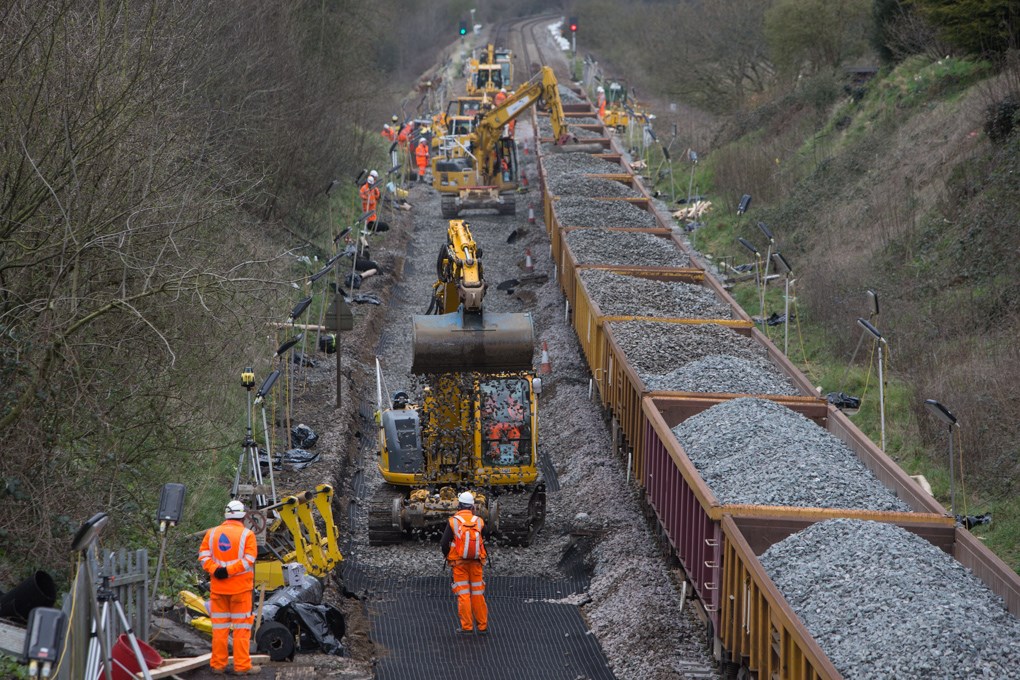Tuesday 12 Apr 2016
Passengers and community thanked for their patience as latest phase of railway electrification work between Bath and Bristol is completed
- Region & Route:
- | Wales & Western: Western
- | Wales & Western
Network Rail and Great Western Railway (GWR) have thanked passengers and people living near the railway for their patience following the completion of the latest phase of work to prepare the railway between Bath and Bristol for a brand new fleet of electric trains.
The work forms part of Network Rail’s £40bn Railway Upgrade Plan to provide a bigger, better, more reliable railway for passengers and involved the ‘orange army’ working round-the-clock to prepare this section of the Great Western Main Line for the arrival of a new fleet of longer, faster, quieter and greener electric trains. The extensive work started at the beginning of the month (2 April) and involved:
- Lowering the tracks at Keynsham station to protect the historic architecture of its footbridge, while creating the extra space needed for the overhead electric lines that will power the new fleet of electric trains to run underneath.
- Platform modifications at Keynsham station following the lowering of the tracks.
- Replacing the tracks at Oldfield Park station to provide greater reliability for passengers.
- Installing the foundations for the overhead electric lines.
Andy Haynes, Network Rail’s project director for the west of England, said: “I’d like to thank passengers and the local community for their patience and understanding while we completed these essential upgrades.
“I’m pleased to say that following our successful track lowering work in Bath last summer, this next stage of the improvement work has also now completed meaning that passengers and residents are another step closer to the benefits that the electrification of the railway will bring.
“These benefits include faster trains with more seats and more legroom, and less noise and cleaner air for those who live close to the railway. Faster journeys and the ability to move more people by train will also benefit businesses in the area, helping to drive economic growth across the south west.”
Rob Mullen, GWR’s general manager central, said: "We are grateful for the patience and understanding shown by passengers as this vital work took place.
"The improvements being made will bring Brunel’s railway into the 21st century, paving the way for new electric trains. These trains will make the most of electrification, providing passengers with more seats, more frequent services and faster journeys, and a step change in customer experience.
"In addition, the ability to reduce journey times while increasing capacity will benefit businesses, helping to drive economic growth across the south west.”
ENDS
Notes to editors
The work involved:
- Over 500 members of the ‘orange army’ working 24 hours a day
- The installation of 10,000 tons of ballast (the stones under the track)
- The removal of 12,000 tons of waste material
- The installation of 1,500 new railway sleepers
- The use of seven engineering trains
- The use of over 25 buses to keep passengers moving during the work, and an additional 49 staff to provide advice and guidance.
About Network Rail’s Railway Upgrade Plan
The Railway Upgrade Plan is Network Rail’s £40bn spending plan for Britain’s railways for the five year period up to 31 March 2019. The plan is designed to provide more capacity, relieve crowding and respond to tremendous growth the railways have seen – a doubling of passengers in the past twenty years. The plan will deliver a bigger, better railway with more trains, longer trains, faster trains with more infrastructure, more reliable infrastructure and better facilities for passengers, especially at stations.
About the Great Western Electrification Programme
Electrification will transform the railway between London and Oxford, Newbury, Bristol and Cardiff to deliver a faster, greener, quieter and more reliable railway for passengers, with extra capacity. Electrifying this part of the Great Western route will enhance 235 miles of one of Britain’s busiest and oldest railways, better connecting major towns and cities across southern England and South Wales. This investment, as well as the introduction of a fleet of new trains, will improve journey times and make services more comfortable, smoother, cleaner and quieter for passengers and people living near the railway.
For more information about the Great Western Electrification Programme, visit: http://www.networkrail.co.uk/great-western-route-modernisation/
Contact information
Passengers / community members
Network Rail national helpline
03457 11 41 41
Latest travel advice
Please visit National Rail Enquiries
Journalists
Victoria Bradley
Media relations manager (Western route)
Network Rail
01793 389749 / 07710 938470
victoria.bradley@networkrail.co.uk
About Network Rail
We own, operate and develop Britain's railway infrastructure; that's 20,000 miles of track, 30,000 bridges, tunnels and viaducts and the thousands of signals, level crossings and stations. We run 20 of the UK's largest stations while all the others, over 2,500, are run by the country's train operating companies.
Usually, there are almost five million journeys made in the UK and over 600 freight trains run on the network. People depend on Britain's railway for their daily commute, to visit friends and loved ones and to get them home safe every day. Our role is to deliver a safe and reliable railway, so we carefully manage and deliver thousands of projects every year that form part of the multi-billion pound Railway Upgrade Plan, to grow and expand the nation's railway network to respond to the tremendous growth and demand the railway has experienced - a doubling of passenger journeys over the past 20 years.
Follow us on Twitter: @networkrail
Visit our online newsroom: www.networkrailmediacentre.co.uk

